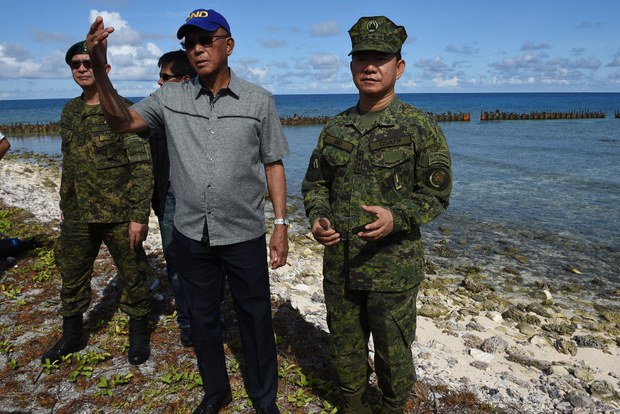Philippines Readies Construction Work on Disputed Spratlys Isle
2017.05.12
Manila
 Philippine Defense Secretary Delfin Lorenzana (second from right) inspects an airport runway during a visit to Pag-asa Island in the Spratlys chain in the South China Sea, April 21, 2017.
Philippine Defense Secretary Delfin Lorenzana (second from right) inspects an airport runway during a visit to Pag-asa Island in the Spratlys chain in the South China Sea, April 21, 2017.
The Philippines is moving military personnel and construction supplies to a disputed island in the Spratlys region of the South China Sea ahead of a multimillion-dollar project to refurbish its dilapidated facilities there, a move that could affect freshly renewed bilateral ties with Beijing.
Facilities on Pag-asa Island have long been in need of an upgrade, analysts said, and while any construction activity would surely anger China, they were hopeful it would not lead to a spike in tensions.
“It’s something that should have been done a long time ago,” Jay Batongbacal, head of the Institute for Maritime Affairs and Law of the Sea at the University of the Philippines, told BenarNews on Friday.
“China will be displeased, but it will have a minimal effect on the overall situation of the parties and status of occupation in the Spratlys region since it will just be repairs and improvement,” he said.
While Beijing could try to block the effort, “hopefully, nothing untoward will happen,” he stressed.
Batongbacal noted that last month, China protested the visit of Filipino defense and military chiefs to Pag-asa, which for decades has been home to a small contingent of Filipino troops and fishermen.
Pag-asa is part of the Spratlys Islands chain believed to lie atop large natural gas and oil deposits. Manila has been on Pag-asa since the 1970s.
Apart from China and the Philippines, the Spratlys chain is claimed in whole or in part by Brunei, Malaysia, Vietnam and Taiwan. The overlapping claims have been cited as a potential flash point for conflict in the region.
The military’s western command has said that supplies had already been ferried to Pag-asa, where the government has earmarked about 1.6 billion pesos (U.S. $32 million) for a fishing port, a power and desalination plant, a radio station and an ice plant.
A marine research sanctuary is being planned, while its old airport runway has been identified as needing immediate repairs, the defense department has said.
Political analyst Richard Javad Heydarian of the De La Salle University in Manila, said there was a strong lobby from the Philippine defense establishment to refurbish its facilities in the region, led by Defense Secretary Delfin Lorenzana.
Lorenzana, who spearheaded the trip last month, has downplayed the Chinese reaction, saying that he personally told the Chinese envoy in Manila about it.
Heydarian said Lorenzana pushed for “a stronger Philippine presence on the ground in light of China’s massive reclamation project and attendant militarization” in the area.
“They are deeply worried about a likely Chinese exclusion zone in the area,” he said, referring to defense officials.
Duterte and China
Duterte’s perceived pro-China stance was a departure from the hard line approach of his predecessor, Benigno Aquino III, who took China to a United Nations-backed international arbitration court in 2013. The court last year ruled in favor of Manila, a month after Duterte won the presidency by a landslide.
Duterte knew he needed to strengthen his patriotic credentials amid growing concerns over his strategic flirtation with China, and “this is why he earlier dispatched leading defense officials to disputed land features and even contemplated a personal visit,” Heydarian said.
China claims nearly the whole of the South China Sea, and recently strengthened its presence there by expanding shoals into artificial islands and building military and other facilities.
While Manila officially contested China’s vast claims, Duterte has taken a more conciliatory approach since assuming office last year. He made a state visit to Beijing and tried to distance the country from the United States, its traditional military ally and counter-balance to China.
As this year’s chairman of the Association of Southeast Asian Nations (ASEAN), Duterte decided to go easy on China and avoided directly mentioning the Spratlys dispute in the regional bloc’s traditional statement by its chairman following a summit last month.
That topic has dominated the regional meeting in past years and a sudden shift in tone caught many off guard.
And in what appears to be a bid to quell dissent from the military, Duterte appointed several ex-generals into his cabinet.
“It’s an astutely crafted unity government that strengthens Duterte’s resilience against any internal challenge,” Heydarian said.







